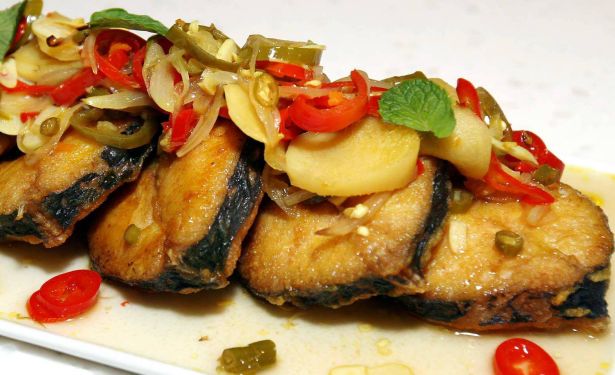Recipe Description
Ayam percik is a traditional Malay speciality that originated from the state of Kelantan. Percik literally translates as splash, but it also means splatter or baste. The name could have been derived from the fatty juices that the chicken sputters as it is being grilled on the open flame, or it could refer to the thickened coconut baste that is splashed on the chicken halfway through roasting.
If you’ve ever driven through Kelantan, you will see stalls upon stalls of ayam percik sellers fanning their wares along the country roads. The air would be filled with the burning of wood and coconut husk, and it will take a bit of restrain to stop at every stall to taste that heady aroma of smoke and spices.
The chickens sold at the stalls are usually quartered so that customers can choose their desired cuts. They are usually bound together with stalks of lemongrass, which are used to not only flip the chicken on the grill but also to contribute more flavour.
You may roast the chicken whole, spatchcocked, or cut up into quarters. I prefer to spatchcock the chicken so that I can roast and baste both the inside and outside of the bird.
The traditional Kelantanese ayam percik tends to be quite sweet, and the traditional sweetener is gula kabung, which you may substitute with gula melaka or even regular white sugar. This recipe may be a bit conservative in its sweetness level for many people but you may add more to your taste.
If possible, charbroil the chicken over an open wood fire rather than roasting in the oven. The fragrance of chicken being slowly roasted golden over the flames will transport you to the Kelantan countryside.
Ayam percik is best eaten with nasi kerabu, another Kelantanese favourite. Log in to kuali.com for the recipes of different versions of this signature dish of Kelantan.
Recipe Ingredient
- For Spice Paste:
- 1 chicken, about 2kg
- 3 red chillies
- 6 dried chillies, soaked in water and squeezed dry
- 10 bulbs shallots
- 5 cloves garlic
- 20g ginger
- 1 stalk lemongrass, sliced
- 20g fresh turmeric or 1 tsp turmeric powder
- 2 tbsp tamarind juice
- ½-1 tsp palm sugar to taste
- ½ tsp salt to taste
- 4 stalks lemongrass skewers
- For Baste Paste:
- 1½ cups coconut milk
- ½ tsp salt to taste
- ½-1 tsp palm sugar to taste
Instructions
- To spatchcock the chicken, cut the chicken along both sides of the backbone with a pair of kitchen shears and remove the spine.
- Spread open the chicken and press down with your palms to break the breast bone.
- Insert a boning knife into the thigh of the bird all the way through the breast, and push in a stalk of lemongrass until it emerges out the other end.
- Repeat with the other stalks of lemongrass in a crisscross pattern and snip off the excess lengths of the lemongrass.
- Blend all the spice paste ingredients into a fine paste.
- Rub half to two-thirds of the spice paste on both sides of the flattened chicken and leave to marinate for 30 minutes.
- Mix coconut milk with salt, palm sugar and remaining one-third to half of the spice paste in a saucepan and bring to a slow simmer until thickened.
- Place chicken skin-side down on a rack over a roasting pan and roast for 30 minutes at 250°C.
- Baste chicken with a thick layer of the thickened coconut milk, flip to skin-side up and repeat the baste.
- Then continue roasting for an additional 15-20 minutes until chicken is done.
- Chicken is cooked if the juice runs clear when a skewer is pierced into the chicken thigh.
- Allow chicken to rest for 10 minutes before serving with nasi kerabu.









